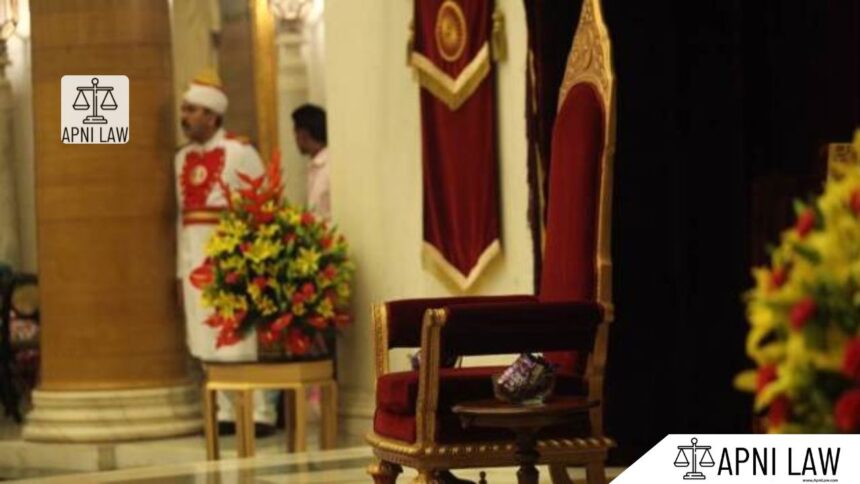The President of India holds the highest constitutional office in the country. The election process reflects India’s federal structure and democratic values. The President is chosen by an Electoral College through a system of proportional representation and a single transferable vote. The Election Commission of India conducts the entire process with a secret ballot to ensure fairness.
Who Elects the President of India?
The President of India is elected by an Electoral College. This body includes the elected members of both Houses of Parliament, namely the Lok Sabha and the Rajya Sabha. It also includes the elected members of the Legislative Assemblies of all States and Union Territories that have their own legislatures, such as Delhi, Puducherry, and Jammu & Kashmir.
Nominated members of Parliament and Legislative Assemblies do not participate in this election. Similarly, members of State Legislative Councils also remain outside the process. This ensures that only directly elected representatives cast votes for the President.
How Is the Value of Votes Calculated?
The system of voting ensures balance between the Union and the States. Each elected MLA’s vote carries a specific value. The value is determined by dividing the population of the state, as per the 1971 census, by the number of elected MLAs in that state. This formula guarantees that larger states do not dominate while smaller states still receive fair representation.
Each Member of Parliament also carries a vote of equal value. The total value of all MP votes equals the total value of all MLA votes across the country. This balance between state and central representation reflects the true federal nature of the Indian Constitution.
What Voting System Is Used in the Election?
The President of India is elected through proportional representation by means of a single transferable vote. The Election Commission of India conducts the election under Article 324 of the Constitution.
The process uses a secret ballot. Voters rank candidates in order of preference. To win, a candidate must secure more than half of the total valid votes, which is called the quota. If no candidate secures this quota in the first round, the one with the least votes is eliminated. The votes of the eliminated candidate are transferred according to the second preference indicated on the ballot. This process continues until one candidate reaches the required quota.
This method ensures that the winning candidate represents the majority preference of the Electoral College rather than a simple plurality.
Who Can Contest the Presidential Election?
The Indian Constitution lays down clear eligibility conditions for Presidential candidates. A candidate must be a citizen of India. The person must be at least 35 years old. The candidate should be qualified to be elected as a member of the Lok Sabha.
The candidate should not hold any office of profit under the Government of India, the Government of any State, or under any local or other authority controlled by these governments. However, certain offices such as the Vice President, Governor, or Ministers do not count as an office of profit for this purpose.
For nomination, the candidate must secure the support of at least 50 proposers and 50 seconders. These proposers and seconders must be members of the Electoral College. Along with the nomination, a candidate also has to deposit a security amount, which is forfeited if they fail to secure a required fraction of votes.
Who Conducts the Presidential Election?
The Election Commission of India organizes the entire process. It prepares the electoral rolls, issues the notification, and sets the schedule for the election. The Commission ensures secrecy and fairness throughout the procedure.
The polling usually takes place in the Parliament House and in the premises of State Legislative Assemblies. The Election Commission makes arrangements for secure ballot boxes and maintains strict protocols. After voting, the sealed ballot boxes are brought to New Delhi for counting.
What Is the Timing of the Presidential Election?
The President of India serves a term of five years. The term begins from the date the President assumes office. However, the incumbent President continues to hold office until the successor takes charge.
The election to fill the vacancy must be completed before the expiration of the current President’s term. If the office falls vacant due to death, resignation, or removal, the election must be held within six months.
In the meantime, the Vice President of India acts as the President until a new President is elected.
What Is the Term of the President of India?
The President of India holds office for five years. The term starts from the date on which the President enters the office. However, the Constitution allows re-election. There is no restriction on the number of terms a President may serve.
The President may also resign before completing the term by addressing the resignation to the Vice President. The President can be removed for violation of the Constitution through the process of impeachment.
How Does the Impeachment Process Work?
The Constitution provides a special process for removing the President. This process is called impeachment. Either House of Parliament can initiate the motion with at least one-fourth of its members giving notice.
The motion must be passed by a two-thirds majority of the total membership of that House. Then, the other House investigates the charges. The President can defend themselves during this process. If the other House also passes the resolution by a two-thirds majority, the President stands removed.
This elaborate procedure ensures that the President cannot be removed casually and that the dignity of the highest constitutional office remains intact.
Why Does the Presidential Election Use a Special Voting System?
The use of proportional representation and single transferable vote makes the Presidential election unique. The system reflects India’s federal character by balancing the voices of the Union and the States.
Direct election by the people would have given larger states greater influence. Election only by Parliament would have ignored the role of the States. The current system combines both and ensures that the President represents the collective will of the nation.
What Happens in Case of a Dispute in the Election?
The Supreme Court of India decides all disputes related to Presidential elections. Any candidate or elector can file an election petition before the Supreme Court. The Court’s decision is final.
The Constitution does not allow any election of the President to be challenged in ordinary courts. This special provision maintains the sanctity and speed of the process.
How Does the Election Strengthen Democracy?
The election of the President involves both national and state representatives. This arrangement ensures that the President represents the entire Union of India. The balance between MPs and MLAs reflects cooperative federalism.
The secret ballot and preferential voting promote independent choice. Members vote without any party whip. This encourages them to act according to their judgment and conscience. The system strengthens the democratic fabric by promoting fairness, balance, and representation.
For any specific query call at +91 – 8569843472
Conclusion
The election of the President of India follows a detailed constitutional procedure. The system blends proportional representation, secret ballot, and preferential voting. It ensures that the President reflects the will of both Parliament and the States.
By balancing Union and State interests, the election underlines the federal nature of the Constitution. It also upholds the democratic principle of fair representation. The office of the President, though largely ceremonial, gains legitimacy from this unique and inclusive election process.








